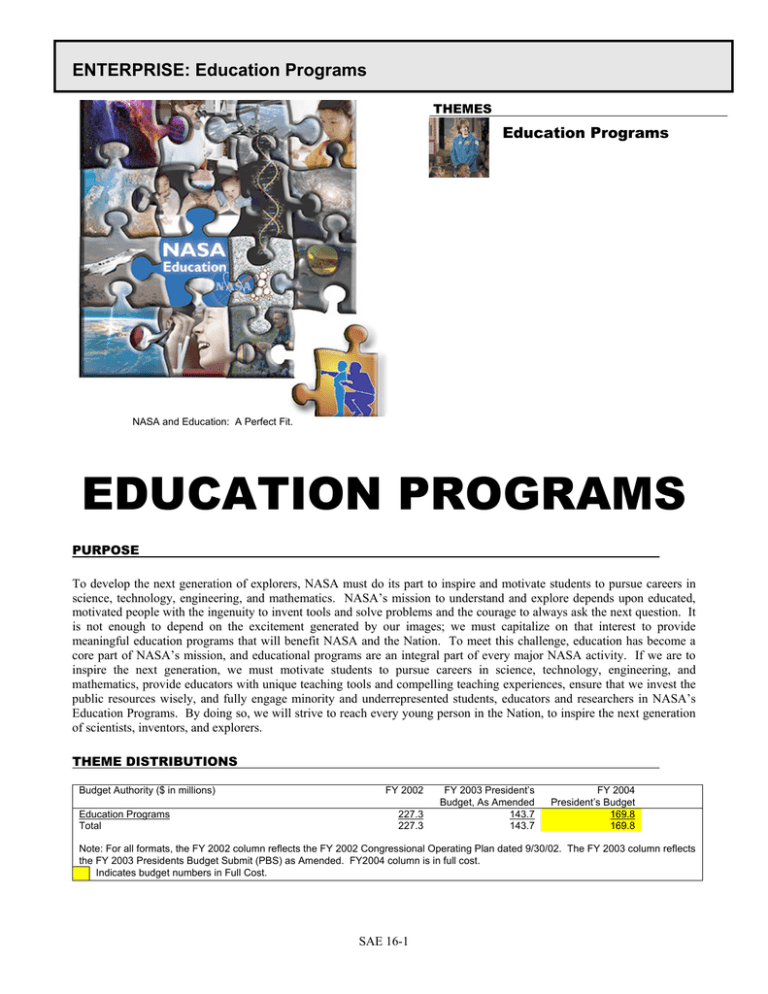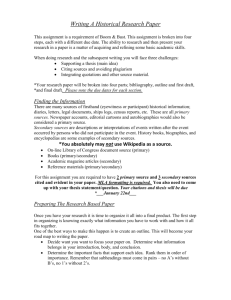EDUCATION PROGRAMS ENTERPRISE: Education Programs Education Programs
advertisement

ENTERPRISE: Education Programs THEMES Education Programs NASA and Education: A Perfect Fit. EDUCATION PROGRAMS PURPOSE To develop the next generation of explorers, NASA must do its part to inspire and motivate students to pursue careers in science, technology, engineering, and mathematics. NASA’s mission to understand and explore depends upon educated, motivated people with the ingenuity to invent tools and solve problems and the courage to always ask the next question. It is not enough to depend on the excitement generated by our images; we must capitalize on that interest to provide meaningful education programs that will benefit NASA and the Nation. To meet this challenge, education has become a core part of NASA’s mission, and educational programs are an integral part of every major NASA activity. If we are to inspire the next generation, we must motivate students to pursue careers in science, technology, engineering, and mathematics, provide educators with unique teaching tools and compelling teaching experiences, ensure that we invest the public resources wisely, and fully engage minority and underrepresented students, educators and researchers in NASA’s Education Programs. By doing so, we will strive to reach every young person in the Nation, to inspire the next generation of scientists, inventors, and explorers. THEME DISTRIBUTIONS Budget Authority ($ in millions) Education Programs Total FY 2002 227.3 227.3 FY 2003 President’s Budget, As Amended 143.7 143.7 FY 2004 President’s Budget 169.8 169.8 Note: For all formats, the FY 2002 column reflects the FY 2002 Congressional Operating Plan dated 9/30/02. The FY 2003 column reflects the FY 2003 Presidents Budget Submit (PBS) as Amended. FY2004 column is in full cost. Indicates budget numbers in Full Cost. SAE 16-1 ENTERPRISE: Education Programs Education Programs The Education Enterprise will provide unique teaching and learning experiences, as only NASA can, through the Agency’s research and flight capabilities. Students and educators will be able to work with NASA and university scientists to use real data to study the Earth, explore Mars, and conduct other scientific investigations. They will work with our engineers to learn what it takes to develop the new technology required to reach the farthest regions of the solar system and to live and work in space. It is important that the next generation of explorers represents the full spectrum of the U.S. population, including minority students and those from low-income families. To ensure the diversity in NASA’s workforce, our educational programs pay particular attention to under-represented groups. NASA Education will support our Nation’s universities to educate more students in science and engineering by providing meaningful research and internship opportunities for qualified students, plus a roadmap for students to seek NASA careers. Highlights for FY 2004 include: Overall budget FY 2004 request is $170 million, a $10 million or 6.1 percent increase over FY 2003 President’s Request (full cost): • $78 million for education programs including the continuation of pipeline development programs for students at all educational levels and the continuation of the Space Grant/EPSCOR programs, providing a national link with the higher education community. • $92 million for minority university research and education including funding opportunities for minority institutions to increase the number and percentage of state-certified mathematics, science, or technology teachers. • Education Enterprise funding is coordinated with an estimated $55 million in education-related funding managed by the five other NASA Enterprises. New Initiative – Education Initiative Request includes $26 million for this new initiative ($130 million over five years): • $2 million for the Educator Astronaut Program that will select teachers and transport them into space to inspire and motivate students. • $13 million for the NASA Explorer Schools Program that will provide target middle schools with a customized and sustained learning environment using NASA’s most recent discoveries and latest technologies to garner greater interest in science and engineering careers. • $9 million for Scholarship for Service that will link scholarship with service at a NASA Center and help NASA better attract top students into our workforce. • $2 million for Explorer Institutes, NASA’s direct link with the informal education community (science centers and museums) through openly competed grants. SAE 16-2







